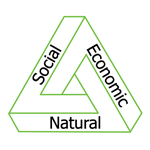Chapter 2 - Standards of Sustainability
Part 6 - Emergy
 In our description of differences in pathways for sustainability, we are often bound into the dilemma of the frustrating consequences of the idiom “comparing apples and oranges.” What then are our options, especially as it applies to sustainability, when we would like to compare two or more processes or products, which at face value are difficult or impossible to compare, with an acceptable degree of objective validity? For example, how can we create a valid argument for paper or plastic grocery bags, or neither, or answer the question of whether the energy and environmental inputs, fully accounted, to extract and process an energy resource, truly yields a significant energy benefit. Can we fully explore what economists call “the externalities” in such a comparison, especially when those externalities, often natural capital, are embedded in the product or process in such a fashion that they escape traditional economic analysis?
In our description of differences in pathways for sustainability, we are often bound into the dilemma of the frustrating consequences of the idiom “comparing apples and oranges.” What then are our options, especially as it applies to sustainability, when we would like to compare two or more processes or products, which at face value are difficult or impossible to compare, with an acceptable degree of objective validity? For example, how can we create a valid argument for paper or plastic grocery bags, or neither, or answer the question of whether the energy and environmental inputs, fully accounted, to extract and process an energy resource, truly yields a significant energy benefit. Can we fully explore what economists call “the externalities” in such a comparison, especially when those externalities, often natural capital, are embedded in the product or process in such a fashion that they escape traditional economic analysis?
A relatively new tool to help with these types of comparisons is called “emergy.” Emergy is a versatile assessment tool, like common transfer functions or derived indices that facilitate the reduction of complex systems into terms that are more readily compared, analyzed, or understood. A common example of a similar approach is the use of pH to indirectly measure the acidity or basicity of a solution.
As defined, emergy is “the available energy of one kind, previously used both directly and indirectly, to make another form of energy, product, or service.” Starting with the base concept that energy comes to the Earth from the sun, emergy might be thought of as energy memory, as the available energy based in a solar photon is transformed into potential and kinetic energy on Earth, often with plant life serving as a major reservoir of chemical energy storage.
The concept of emergy, based on energy systems theory, quantifies relationships between economy, environment and culture using a common metric, allowing these different aspects of the whole system to be related. Emergy provides a way to understand things such as aesthetic and symbolic values, and their relation to human willingness to pay. It can also assist in determining the overall sustainability of an approach, and whether long term economic growth will be helped or hindered.
We have a continuing need to evaluate new technologies as they arise to determine their feasibility, the first test being that they provide net emergy to society, which is a more stringent criterion that simply net energy.

Keywords
- emergy
- Howard T. Odum
- emergy flow
- energy systems theory
- emjoule
- energy memory
- transformity
- emdollar
Reading
- "Emergy and Its Importance" https://www.researchgate.net/publication/237090541_Emergy_and_Its_Importance Daniel Campbell (2008) USEPA Environmental Research Brief. EPA/600/S-08/003. 2 pages.





